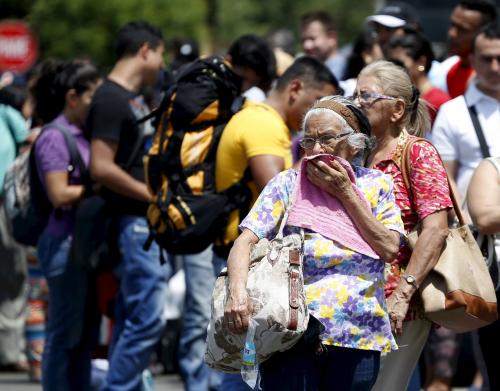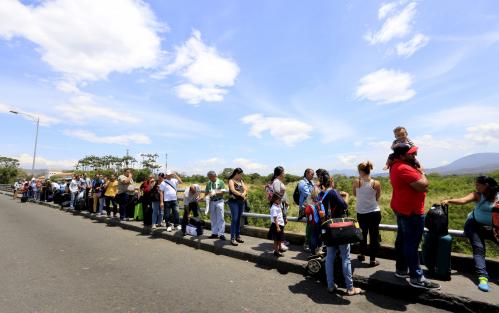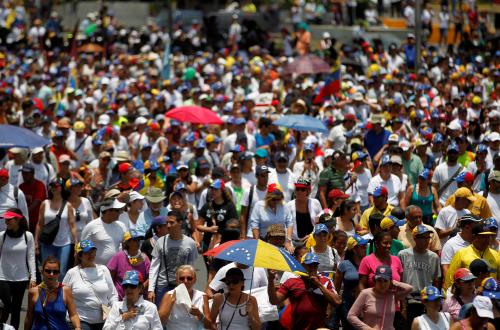Venezuelans who have fled the country already surpass the 3 million mark, with over one million in Colombia. Colombian authorities have stated that they expect the amount of Venezuelans in the country to double over the next 12 months. Venezuela appears to be tragically stuck in a perverse modern-day “Malthusian trap”, where lack of access to food is an important determinant of the emigration rate. The current conditions are so bad that even if the government were to put all of its net income from oil—Venezuela’s main and almost only export, which is publicly owned—to feed the poorest of the poor, there would still be a substantial portion of the population whose basic caloric needs wouldn’t be covered.
The tool we developed, presented below, shows that, based on factors that determine Venezuela’s foreign income—oil production, price of oil, and inflows of other sources of foreign resources such as remittances—the total number of Venezuelan migrants and refugees around the world could reach 8.2 million. Our calculation includes the 3 million Venezuelans already outside the country. If this happens, the Venezuelan tragedy would eventually surpass the Syrian refugee crisis, as we argued in an earlier post. Slight changes in the conditions defining the economic situation in the country can significantly affect the expected number of total migrants and refugees, as can be seen below.
Our baseline scenario reflects current conditions. Venezuela’s oil production capacity has collapsed and, by November 2018, the country produced 1.17 million barrels per day (mbpd). The average price of Venezuelan oil in November 2018 fluctuated between $53 and $55 per barrel; and, according to some independent sources, remittances are estimated to be $2.4 billion per year. The model uses several assumptions that we detail in this document.
How do we reach these numbers? We model how many calories could be imported if all the foreign currency entering the country is used to import food to assist the population in need. In our model, those resources include government funding through net income from oil exports plus private resources in the form of remittances. Furthermore, the model assumes that imports of food are efficient: the country only imports goods that will deliver the largest nutritional benefit at the lowest cost possible, with goods allocated perfectly so that each individual receives just enough to complement their current intake up to minimum nutritional standards. Thus, if the process is not as efficient as we assume, we are likely underestimating the numbers.
Whatever assumption we use, however, one key takeaway is clear: The current situation in Venezuela is so critical that all available resources flowing into the country are simply not enough to import all the necessary food to complement the basic nutritional needs of those citizens living under the poverty line. We estimate that people whose minimum caloric needs cannot be met under these dynamics will eventually be forced to migrate.
Note that this is a rather simple model. Some of those that cannot meet minimum subsistence levels may be too weak to be able to endure the difficult journey faced by many Venezuelan migrants. Alternatively, the remaining population that can meet subsistence levels would be by no means living well—indeed, they would face significant food insecurity, limited access to medicine and appropriate medical treatments, political crackdowns, and rampant criminal activity. Thus, this latter group may also be compelled to migrate. Hence, this model does not intend to be a precise estimate of migration flows, but rather to indicate its potential scale.
Our tool shows that things can get worse rapidly. If oil production keeps collapsing, and reaches one mbpd, while everything else remains equal, we could expect the total number of migrants and refugees to reach over 10 million. Even if the price of oil recovers in 2019 to a level around $60 a barrel, which may be a high estimate based on the current quotes of oil futures, that still wouldn’t be enough to prevent a significant increase in the scale of the Venezuelan migrant crisis.
Recently the U.N. announced an allocation of $9.2 million in emergency relief funds to Venezuela. To reverse the humanitarian catastrophe that compels people to migrate, our model shows, large scale aid is needed, probably billions worth. This assumes that whatever amount of foreign aid extended in an agreement with the Venezuelan government—whether $9 million or any other amount—will be used to help the people of Venezuela and not get lost in one of the many corruption schemes deployed by the government.
Venezuela’s migration and refugee crisis will likely worsen in the absence of things changing for the better in Venezuela. We acknowledge the simplicity of our model and are fully aware that this crisis is due to many more factors than are included in our simple equation. Many other pulls and push factors help propel each individual and his or her family to leave everything behind and flee, a dynamic that should not be minimized. We only hope we can contribute with an estimate for the region to prepare accordingly, based on important parameters determining the depth of Venezuela’s humanitarian crisis, a tragedy created by the current regime.
The Brookings Institution is committed to quality, independence, and impact.
We are supported by a diverse array of funders. In line with our values and policies, each Brookings publication represents the sole views of its author(s).








Commentary
How many more migrants and refugees can we expect out of Venezuela?
December 10, 2018